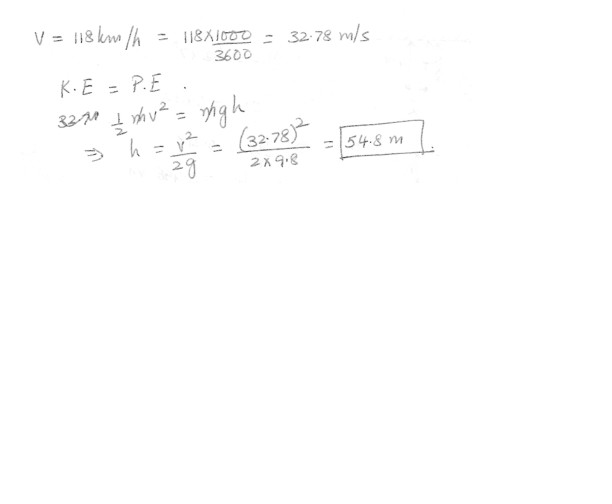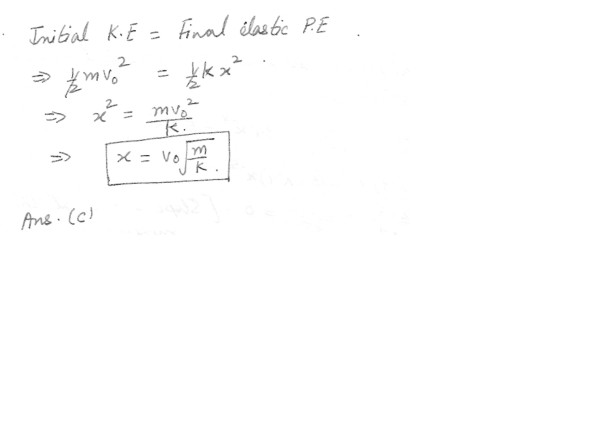Physics Work,Power & Energy Level: High School
Conservation of Energy
A 11 kg child on a playground swing moves with a speed of 9.4 m/s When the 1 m long swing is at its lowest point . The acceleration of gravity is 9.81 m/s2 . What is the angle that the swing makes with the vertical when the swing is at its highest point ? Answer in units of degrees .
Physics Work,Power & Energy Level: High School
Conservation of Energy
A child slides without friction from a height of 10.2 m above the water along a curved water slide , as shown below . She is launched from a height 5.9 m above the water at an angle of 51 degrees above the horizontal toward a pool . The acceleration of gravity is 9.81 m/s2 . Determine her maximum airborne height above the water . Answer in units of m .
Physics Work,Power & Energy Level: High School
Conservation of Energy
A block of mass 0.34 kg placed on a vertical spring of constant 2657 N/m and pushed downward, compressing the spring 0.13 m . After the block is released it leaves the spring and continues to travel upward . The acceleration of gravity is 9.8 m/s2 . What height above the point of release will the block reach if air resistance is negligible ? Answer in units of m .
Physics Work,Power & Energy Level: High School
Conservation of Energy
Consider a frictionless roller coaster. Passenger cars starts at point C with zero initial speed , accelerate as they go down, swing around a circular vertical loop, then go on towards further adventures. When a car goes through the top of the loop (point B), the passengers feel weightless (for just a moment) What is the height h of the starting point C ?1) h = (3/4) R
2) h = (7/2)R
3) h = 3R
4) h = 2R
5) h = R
6) h = (7/3)R
7) h = (1/4)R
8) h = (1/3)R
9) h = (5/2)R
10) h = (2/3)R

Physics Work,Power & Energy Level: High School
An elevator is rising at constant speed . Consider the following statements:i) The upward cable force is constant .
ii) The kinetic energy of the elevator is constant .
iii) The gravitational potential energy of the earth-elevator system is constant.
iv) The acceleration of the elevator is zero.
v) The mechanical energy of the earth-elevator system is constant .
Which of the following statement are true ?
1) only i, ii and iii are true .
2) only, ii and v are true
3) All fiver are true
4) only i, ii and iv are true .
5) only iv and v are true .
Physics Work,Power & Energy Level: High School
Conservation Of Energy for a Spring
A pinball machine launches a 99 g ball with a spring-driven plunger . The game board is inclined at 8 degrees above the horizontal . Assume: The plunger’s mass and frictional effects are negligible. The acceleration of gravity is 9.8 m/s2 . Find the force constant k of the spring that will give the ball a speed of 97 cm/s when the plunger is released from rest with the spring compressed 3 cm from its relaxed position . Answer in units of N/m .
Physics Work,Power & Energy Level: High School
Conservation Of Energy
A mass m is released from a height h above the ground , It is given an initial horizontal velocity of magnitude v0 . What is the speed of the mass when it hits the ground ?1) v = square root (2gh)
2) Undetermined , since we don’t know the angle at which the mass hits the ground.
3) v = square root (v0 squared + 2gh)
4) v = square root(gh/2)
5) v = square root ((v0 squared/2)+gh)
6) v = square root ((v0 squared/2)+9gh/2)
7) v = square root (v0 squared + (gh/2))
8) v= square root (gh)
9) v = square root (v0 squared + gh)

Physics Work,Power & Energy Level: High School
Elastic Potential Energy
An ore car of mass 43000 kg starts from rest and rolls downhill on tracks from a mine . At the end of the tracks , 7.7 m lower vertically , is a horizontally situated spring with constant 490000 N/m . The acceleration of gravity is 9.8 m/s2 . Ignore friction . How much is the spring compressed in stopping the ore car ? Answer in units of m .
Physics Work,Power & Energy Level: High School
Conservation of Energy
Consider a compact car that is being driven at 118 km/h . The acceleration of gravity is 9.8 m/s2 . From what height would the car have to be dropped to have the same kinetic energy ? Answer in units of m .
Physics Work,Power & Energy Level: High School
Conservation of Energy
A 8.8 kg mass is attached to a light cord that passes over a massless, frictionless pulley . The other end of the cord is attached to a 2.2 kg mass . The acceleration of gravity is 9.8 m/s2 . Uses conservation of energy to determine the final speed of the first mass after it has fallen (starting from rest) 6.3 m . Answer in units of m/s .
Physics Work,Power & Energy Level: High School
Conservation of Energy
A frictionless pendulum of length 3 m swings with an amplitude of 10 degrees . At its maximum displacement , the potential energy of the pendulum is 10 J . What is the kinetic energy of the pendulum when its energy is 5 J ?1) K = 5 J
2) K = 10 J
3) K = 15 J
4) K = 6.7 J
5) K = 3.3 J

Physics Work,Power & Energy Level: High School
Elastic Potential Energy
A block of mass m slides on a horizontal frictionless table with an initial speed V0 . It then compresses a spring of force constant k and is brought to rest . The acceleration of gravity is 9.8 m/s2 . How much is the spring compressed x from its natural length ?a) x = v0 (m/kg)
b) x =v0 (mg/k)
c) x = v0 x Square root of m/k
d) x = (v0 squared /2g)
e) x = v0 x square root of k/m
f) x = (v0 squared /2m)
g) x = v0 x square root of mg/k
h) x = v0 (mk/g)
i) x = v0 (k/gm)
j) x= v0 x square root of k/mg

Physics Work,Power & Energy Level: High School
Elastic Potential Energy
It takes 2.39 J of work to stretch a Hooke’s-law spring 4.3 cm from its unstressed length . How much the extra work is required to stretch it an additional 15.3 cm ? Answer in units of J .
Physics Work,Power & Energy Level: High School
Power
Water flows over a section of Niagara Falls at a rate of 1.47 x 10^6 kg/s and falls 30 m . The acceleration of gravity is 9.8 m/s2: How many 40 W bulbs can be lit with this power ?
Physics Work,Power & Energy Level: High School
Potential Energy
The potential energy between two atoms in a particular molecule has the form U(x) = (3.1/x^8)-(5.3/x^4) where the units of x are length and the numbers 3.1 and 5.3 have appropriate units so that U(x) has units of energy. What is the equilibrium separation of the atoms (that is the distance at which the force between the atoms is zero) ?
